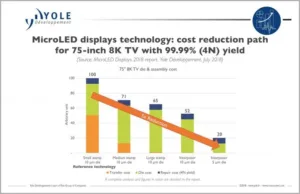MicroLEDs technologies are improving rapidly and new technology paths emerging at a rapid pace. According to Yole Développement’s analysts, technology solutions should start converging by the end of 2019.
The challenge is now focused on cost reduction. What is the feasibility of each solution? Can microLED TV or smartphone display manufacturing costs be compatible with these applications? Which cost reduction paths are the most realistic?
In its latest microLEDs report “MicroLED Displays 2018”, the market research and strategy consulting company Yole Développement (Yole) proposes a comprehensive technology and market overview including a detailed cost analysis with the contribution of die and assembly costs. Yole’s microLED report also highlights all critical technology blocks with a focus on the most recent advancements, emerging options and remaining challenges.
“Technology advancements pave the way for various cost reduction paths toward volume manufacturing”,comments Dr. Eric Virey, Senior Market & Technology Analyst at Yole. “But none are straightforward…”
In addition an overview of the key players, the supply chain and the competitive landscape analysis are available in Yole’s report (including front end and display assembly players). The consulting company did not see any major changes regarding market evolution. More and more companies are looking into the attractive microLEDs sector, and scrambling to figure out the best way to participate and which technology paths are the most suitable.
Yole’s analysts offer you today an up-to-date status of the microLEDs industry.

Dozens of technologies are being developed for microLED assembly and pixel structures. The cost and complexity range can be staggering. However, there are some fundamentals that anchor all those processes. Alignment dominates assembly cycle times, die size can’t get infinitely small, epitaxy cost has already been through a more than 20 years on the cost reduction curve. Cost analysis therefore allows companies to narrow the process parameters down to economically realistic windows and identify efficient cost reduction strategies.
“MicroLED companies must understand the cost targets for each application and work backward, making process choices and developing each step so it fits the cost envelope,” asserts Dr. Eric Virey from Yole. Processes that can’t deliver the right economics will disappear. If none can deliver the right economics, the opportunity will never materialize. MicroLED is entering the valley of death between technology development and industrialization and commercialization.

As the technology improves, there are credible cost reduction paths for microLED to compete in the high-end segment of various applications such as TV, augmented and virtual reality (AR/VR) and wearables. With the right approaches, assembly cost could become a minor contributor. For smartphones, however, approaching OLED cost implies pushing microLEDs toward what is likely to be the limits of the technology in term of die size. To succeed, microLEDs will have to count on some level of price elasticity. It must deliver performance and features that no other display technology can offer and that are perceived by the consumer as highly differentiating. Microdisplays for AR and head-up displays (HUD) will be the first commercial applications, followed by smartwatches. TVs and smartphones could follow 3-5 years from now.
A detailed description of the MicroLED Displays, 2018 report is available on i-micronews.com, Display reports section.
Yole’s team attended IMID 2018 end of August with two presentations, available today on i-micronews.com:
• MicroLED Displays: Hype and Reality, Hopes and Challenges”, August 30 – Speaker: Eric Virey, Principal Analyst, Technology & Market, Sapphire & Display.
• “The Landscape of Electroluminescent Quantum Dots Technology: Trends and Opportunities”, August 29 – Speaker: Zine Bouhamri, Technology & Market Analyst, Displays at Yole Développement.
Next date will be at OLED World summit, mid-September. The consulting company proposes you a relevant presentation focused on MicroLEDs solution, as an alternative to OLED technologies. More information on i-micronews.com.
Stay tuned!

